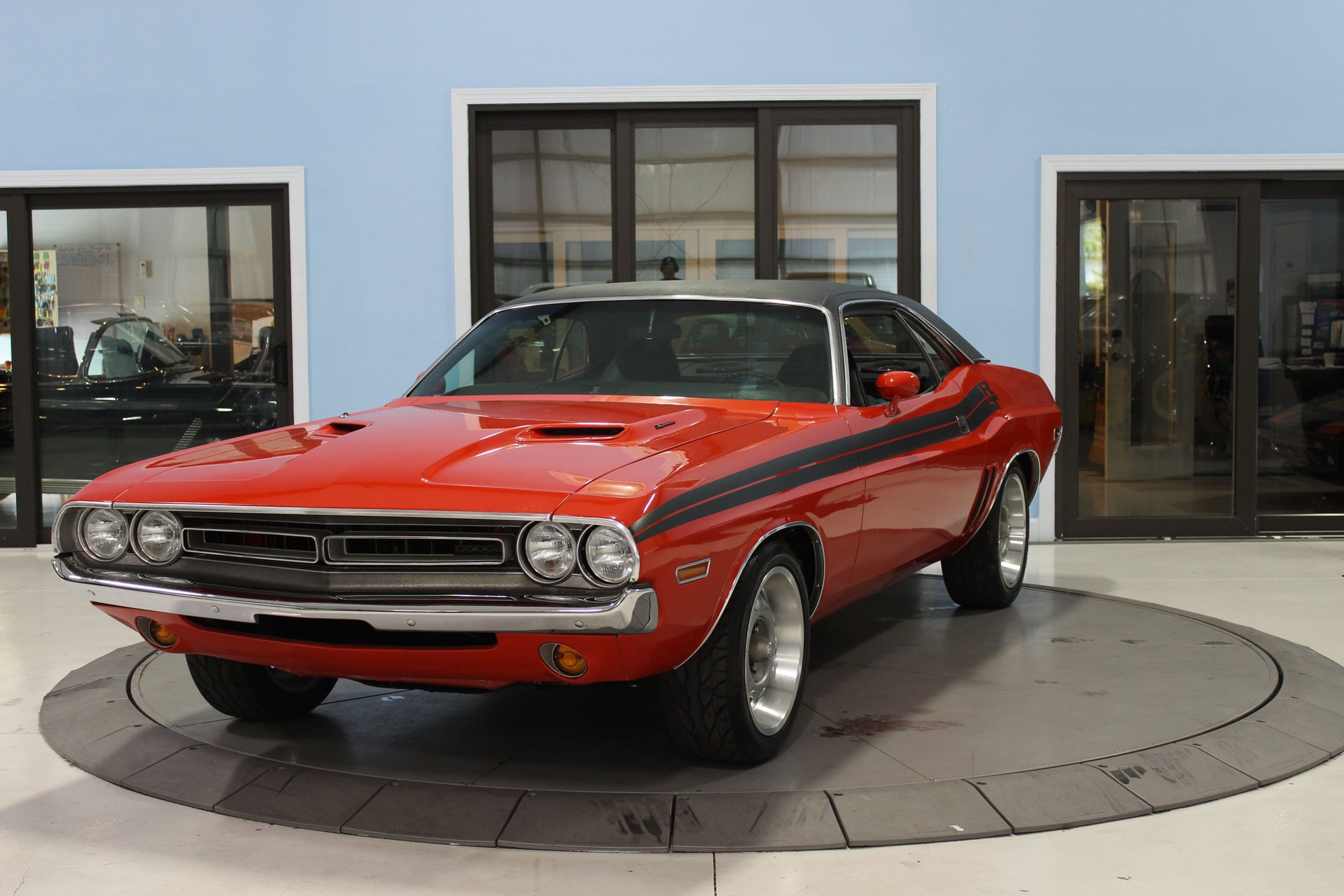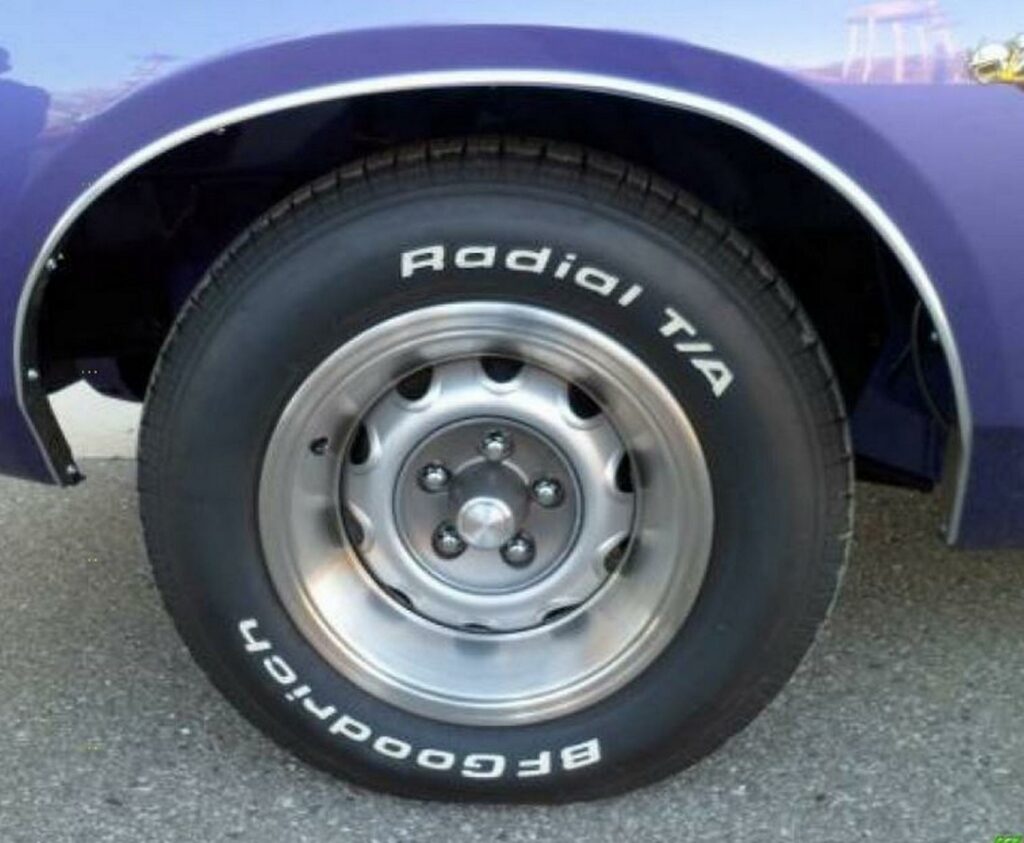What does a company do after posting an 80,000 car sales year? Well, if they are smart, not too much. The ‘71 Challenger fell into that category. The gas/emissions crisis was just starting to hit, but the sporty car was still very alive. It wouldn’t, however, be the waterfall of sales like the 1970 model even though the car sported most of the same features.
| Model | 1971 Dodge Challenger |
| Type | 2-door |
| Names & Trims | Coupe, Convertible, R/T |
| Engines | 189ci I6, 225ci I6, 318ci V8, 383ci V8, 440ci V8, 440 six-pack, 426ci Hemi |
| Price range | $2,737-$3,273* |
*Consumer Guide: Encyclopedia of American Cars
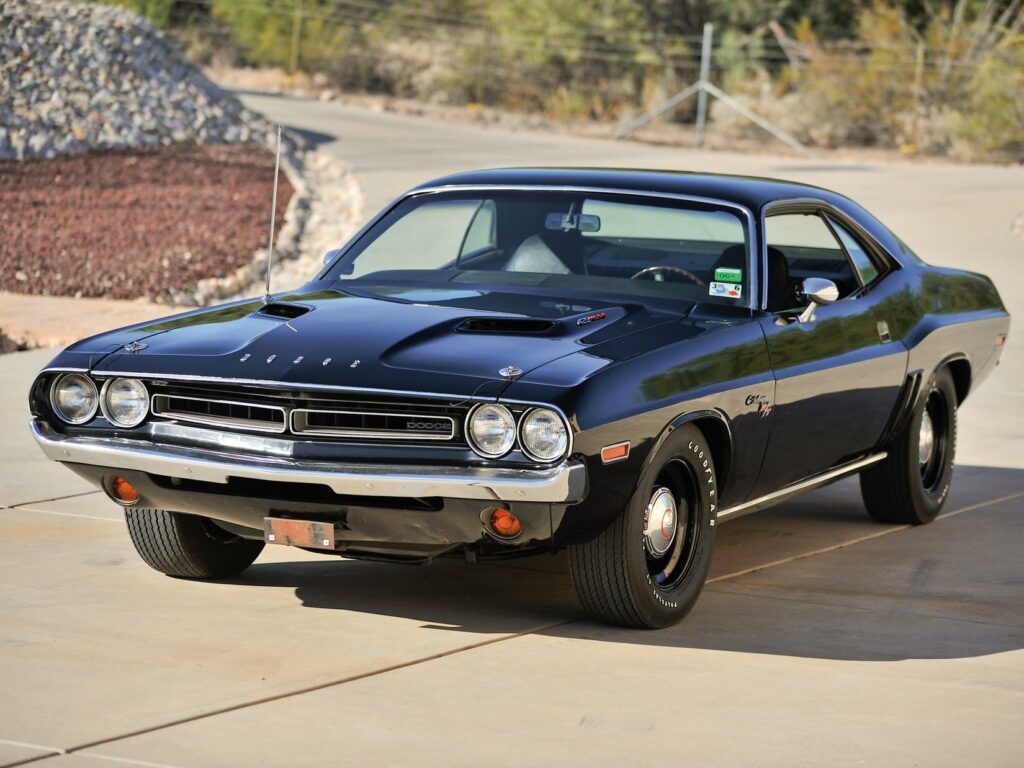
Even though the ‘70 and ‘71 Challengers look identical – face value – the cars’ line-ups are immensely different. The line-ups went from two-hands-full, down to a mere 4 options. Gone were many of the “initialed” names – and with them – a lot of pomp and circumstance. Tougher to be excited about a “Hardtop” than a “SPECIAL Edition”.
More than this, the color options were down some, the engines were starting to feel the de-tune crunch, and the sales floor was scrambling to meet even a third of the last years’ totals. As much as the Challenger was a good-looking muscle car, there was no stopping the change in buyers’ demands.
1971 Exterior Changes
Externally, the front of the car is about the biggest change for the ‘71 year. The lights became closer together and the grille lengthened. The grill was also changed to a thinner, angled look vs. a flat look. I believe it to be a stretch to say “more aerodynamically” shaped, but it is more than just the “blockish” flattened look of the ‘70.


The rear of the car was also a noticeable change. The taillights were made slightly smaller and were accented more than the ‘70. The back-up light was moved from the spot between the two lights to inside the middle of each light. These went from their own style to looking like that of the ‘69 Camaro. Dramatic change to say the least, but one that did nothing for sales.


As for the remainder of the car, the design was kept pretty close to the 1970’s. Dummy rear brake vents were added to the rear quarters as an option, and you could still opt for wings, stripes, spoilers, and the like. The look was still there, even if it was a bit less surprising and startling as the previous year.. Honestly, to the untrained eye.. it is a ‘70 all the same.
Available 1971 Challenger Models
Challenger
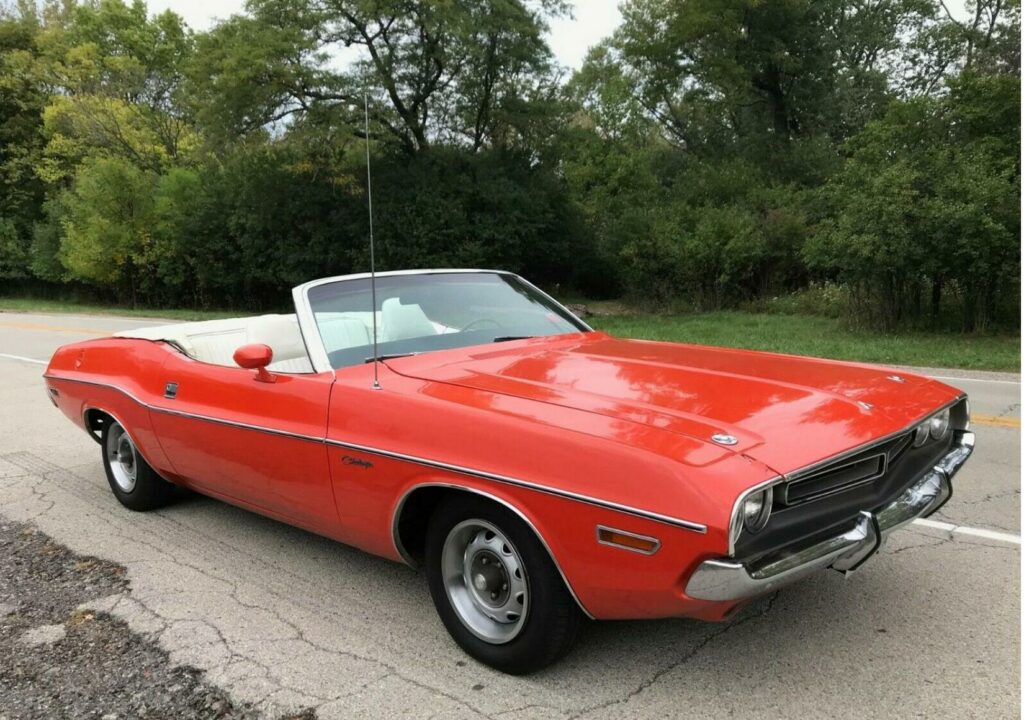
The starting point for ‘71 was now referred to as “Challenger” – with the “Deputy” now being just a base options list and sold in very small numbers. Standard features included all-vinyl bucket seats in black, and black and white. You’d also get a heater/defroster, 14” hubcaps, parking brake, aluminum muffler and exhaust, and the 198ci, I6. Optionally you could also get the 318ci, V8, 3-speed console automatic, seats in dark green, bright blue, saddle colors, and fixed rear window glass.
Challenger Hardtop/Convertible

The next level of Challenger was now the hardtop coupe or convertible coupe (as the Special Edition was dropped completely). Options were deep here and ranged from simple items like a wood-grain steering wheel, a deeper range of interior colors, and cigarette lighter, to major items like a 4-speed manual transmission, and vinyl roof covering. Pricing would be more of a premium back then and getting more expensive nowadays.
Challenger R/T

The last stop in the significantly smaller list of models was the R/T (Road and Track). These were the top echelon of performance Challengers and the options were extensive. Using the vast color palette, you could design a 440 six-pack in sublime green R/T with a shaker-hood, or go for the softer spoken all-black, no-frills, 426 Hemi look. There was little you couldn’t get for these cars and some of the top-end ones will run you in the 6-figure range in today’s market.
1971 Dodge Challenger Specifications, Options, & Interior
Physical Dimensions
The 1971 Dodge Challenger’s physical dimensions:
- Length: 191.3 inches
- Width: 76.3 inches
- Height: 51 inches
Interior
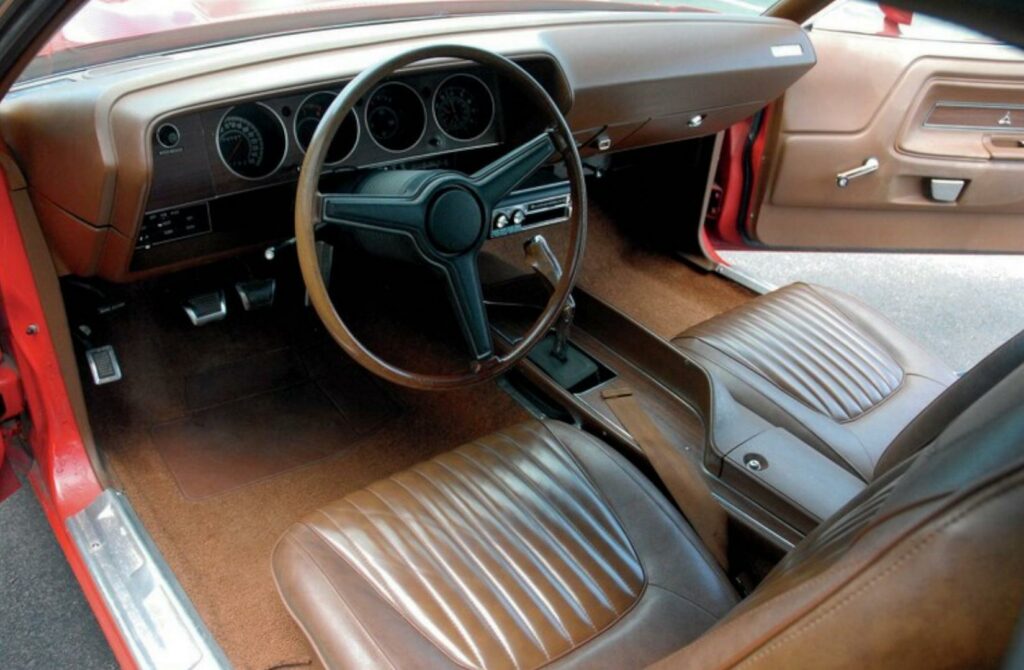
A more diverse color range and some little nuances aside, the ‘71 Challenger was as similar a place to reside as the previous year. The seats were slotted differently, there were more vibrant colors (like green and blue), and the shifter was downgraded to a plastic “T” inside the console, but the remainder was pretty similar… and all pretty good. Like all Mopars by this point, however, you were starting to see the transition to the ‘70’s look vs the ‘60’s.
Hoods
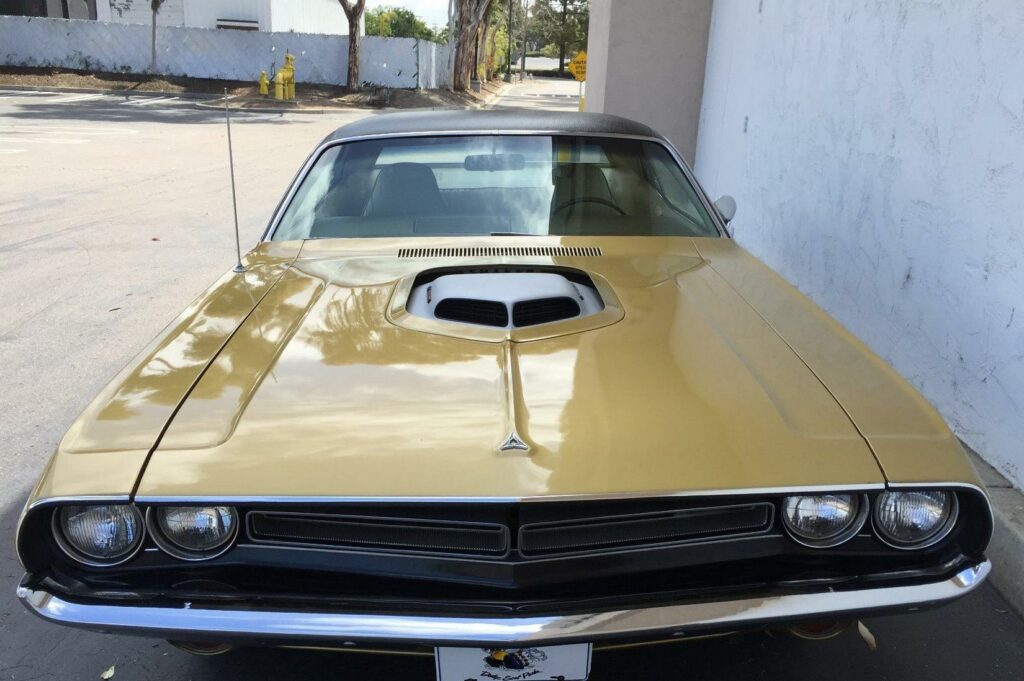
For 1971, the Challenger retained most of the same hoods as 1970. You still had a well-styled “base” hood with a few grooves standard. As you opened your bank account further, you’d get the vented R/T hood and then with more funds, the stripe on top. These were the most prevalent of the performance hoods and far easier to upkeep than the next in the list.
Referring to the shaking top of the engine, the “shaker” hoods were the quick way of knowing something fierce was before you. Usually atop the 440 six-pack or its nemesis 426 Hemi, these were awesome looking machines – and they had the excessive speed to match as well. Unfortunately, the T/A model was dropped, so the fiberglass hood with the dramatic scoop was gone. A loss to say the least.
Vinyl Tops
A gold colored top was now offered but the Gator Grain was deleted. Other colors were unchanged.
1971 Dodge Challenger Engines
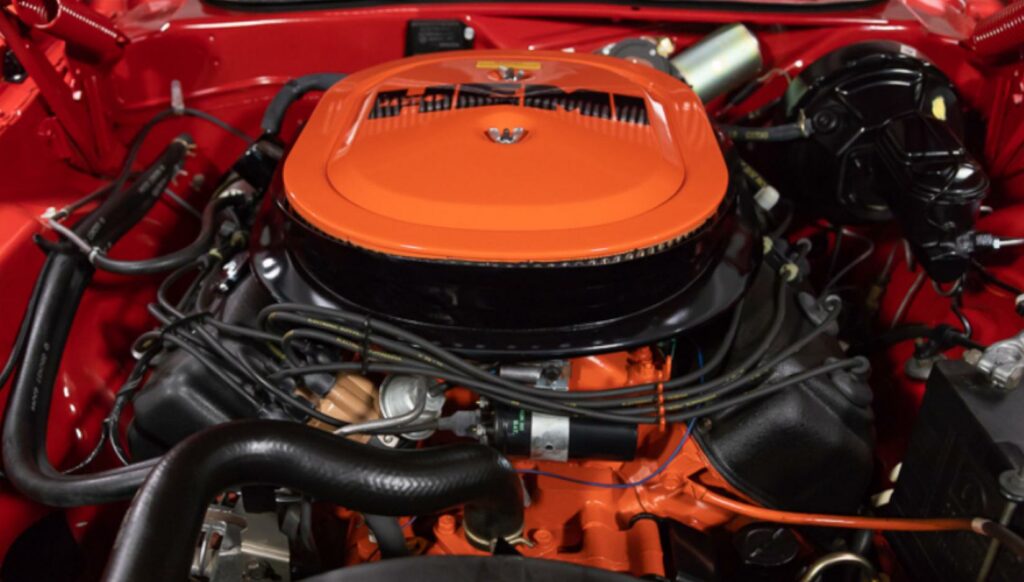
1971 “Standard” Engine Specifications
| Displacement/
Cylinders |
198 ci I6 | 225 ci I6 | 318 ci V8 | 340 ci V8 | 383 ci V8 |
| Bore & Stroke (in.) | 3.4×3.64 | 3.4×4.12 | 3.91×3.31 | 4.04×3.31 | 4.25×3.38 |
| Carburator | 1bbl | 1bbl | 2bbl | 4bbl | 2bbl |
| Compression | 8:4:1 | 8:4:1 | 8:6:1 | 10:3:1 | 8:5:1 |
| Air Cleaner | Single | Single | Single | Dual | Single |
| Exhaust System | Single | Single | Single | Dual | Single |
| Crankcase | 3¼ quarts – 4 quarts when replacing oil filter on all engines except the 440 and 426 when it is 5 and 6 respectively.
Closed crankcase ventilation with cleaner air system standard on all engines. |
||||
| Coolant | 10.8 qts. | 10.8 qts. | 13.3 qts. | 12.5 qts | 12.1 qts |
| Horsepower | 125 @ 4400 | 145 @ 4000 | 230 @ 4400 | 275 @ 5000 | 275 @ 4400 |
| Installed NET Horsepower | 105 @ 4400 | 110 @ 4000 | 155 @ 4000 | 235 @ 5000 | 190 @ 4400 |
| Fuel Recommended | Regular | Regular | Regular | Premium | Regular |
1971 High-Performance Engine Specifications
| Displacement/
Cylinders |
383 ci V8 | 440 ci V8 | 426 ci V8 |
| Bore & Stroke (in.) | 4.25×3.38 | 4.32×3.75 | 4.25×3.75 |
| Carburator | 4bbl | 3x2bbl | 2x4bbl |
| Compression | 8:5:1 | 10:3:1 | 10:2:1 |
| Air Cleaner | Double | Unsilenced | Unsilenced |
| Exhaust System | Dual | Dual | Dual |
| Crankcase | 3¼ quarts – 4 quarts when replacing oil filter on all engines except the 440 and 426 when it is 5 and 6 respectively.
Closed crankcase ventilation with cleaner air system standard on all engines. |
||
| Coolant | 12.1 qts. | 12.9 qts. | 13.3 qts. |
| Horsepower | 300 @ 4800 | 385 @ 4700 | 425 @ 5000 |
| Installed NET Horsepower | 250 @ 4400 | 330 @ 4700 | 350 @ 5000 |
| Fuel Recommended | regular | premium | premium |
For Starters…
There were some interesting, but mostly minor changes to the engine line-up for 1971. To start with, the 340ci V8 was now a standard option. An excellent engine, it would be one of the better small blocks you could get and was only de-tuned 15hp from the previous year.
Due to lower compressions, the lower and higher output 383ci V8s were both down in power. The lower dropped 15hp to 275hp, and the upper 383 was down to 300hp – some 30 horsepower drop. Torque ratings – though not shown here – were also down in some cases.
For a bit more power…
From here you got to the big change in the engine line-up. The base 440ci 4-barrel was removed completely. Your only option was the over-the-top 440 six-pack. This would’ve made for some tough decisions and is most likely the biggest reason there are few true ‘71 440s in circulation. The six-pack was also reduced to 385 horsepower – 5hp down. Not entirely a deathstroke, but still a sign of the times.
The final engine was still the 426 hemi. It was the only untouched performance engine for 1971 and was still THE most powerful and most coveted. Rated at the same 425hp, these were the baddest Challengers on the road and though the 1970 gets the nod as the best Challenger hemi you can buy, the 1971 hemi would be similarly just as quick through the quarter – in the mid 13-second range. Sadly, only 47 would be produced for 1971.
1971 Challenger Transmissions
- The base transmission would be the 3-speed automatic in column or console shifting styles or a 3-speed manual floor shift. This was available in A903/904 for the lower engines and A833 for the engines bigger than the 318ci.
- The next style for the performance engines would be the 727 Torqueflight automatic. This was used in anything above the 340ci engine and was a very resilient transmission.
- Lastly would be the 4-speed that would come with a pistol-grip shifter (a wooden top in the shape of a hand-gun grip). These were optioned with regular and limited-slip differentials.
1971 Challenger Wheels & Tires
The left-hand thread wheel nuts that had been fitted to the 1970 model driver’s side were done away with. On the Rallye wheels, the trim ring now had a brushed finish and the wheel center was a dark gray.
| Engine | Standard | Optional | Recommended Brand |
| 198/225/318 | 7.35×14 | E78x14,F70x14*,E60x15** | Goodyear |
| 383 | F78x14 | F70x14*,E60x15**# | Goodyear/Polyglas GT |
| Engine | Standard | Optional | Recommended Brand |
| 340 | F70x14 | F78x14,E60x15# | Goodyear/Polyglas GT |
| 383 | F70x14 | F78x14 | Goodyear/Polyglas GT |
| 426/440 | F70x14 | E60x15# | Goodyear/Polyglas GT |
* Only with HD suspension.
** Only with HD suspension and disc or HD brakes. # N/A with Air Cond.
1971 Dodge Challenger Production Numbers
1971 was an “average” year for the Challenger, but the dropping numbers couldn’t be ignored. With just over 4,500 R/T models sold, the performance fire was already being snuffed out. It also makes them a rare and expensive commodity today. They sold the following units:
|
Challenger Coupe |
23,088 |
| Challenger Hardtop Coupe | |
| Challenger Convertible Coupe | 2,165 |
| Challenger R/T Hardtop Coupe V-8 | 4,630 |
*Consumer Guide Encyclopedia of American Cars



